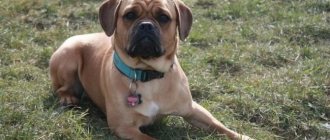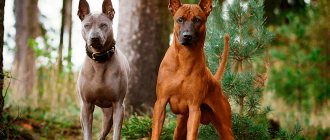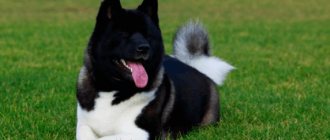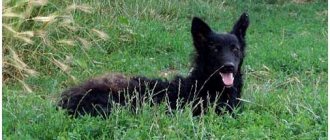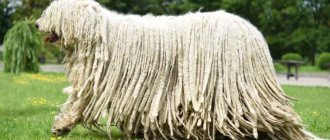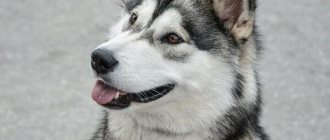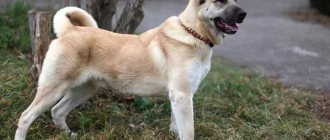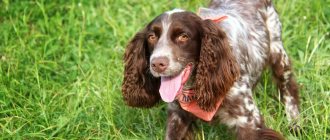The Thai Ridgeback (TRD, Mah-Tai) is one of the oldest dog breeds. Thais attract attention with their noble appearance, interesting color and unusual ridge along the back. There are only three breeds of dogs with a crest in the world: the Rhodesian Ridgeback, the Vietnamese Phu Quoc and the Thai Ridgeback, which will be discussed in this article.
Content
The Ridgeback has a developed hunter's instinct - he can track down and hunt down a cat, small rodent or squirrel. If you live in a city and do not plan to use your dog for hunting, stop any attempts at stalking from an early age. Otherwise, the dog is suitable for family life and plays the role of a companion well.
Need for physical activity
The Ridgeback requires walking two to three times a day. During a walk, he turns from a calm house dog into a hurricane of emotions. The dog runs, jumps and frolics - he gives free rein to his energy. Ridgebacks can run very fast, so be careful when walking them.
The dog prefers to stay in familiar territory - he does not like walking in new places. And the Thai is afraid to swim and cannot stand water.
A pregnant Ridgeback bitch can be walked as usual in the first half of her term, and in the second half, the number of walks can be increased to 4 per day, while reducing the time spent on the street and monitoring the animal’s activity.
Appearance care
The Thai Ridgeback does not drool on the floor, sheds little and maintains its own hygiene.
The owner can only perform some hygiene procedures:
- clean your ears – once a week;
- trim claws - once a month in winter;
- wash your eyes once a day;
- comb the fur three times a week.
Thai Ridgeback: photo, standard and description of the dog breed
Nutrition
The dog is carnivorous by nature, so the basis of its diet should be meat. But you cannot feed an animal only meat - the diet must be balanced.
Be sure to include:
- cereals – rice, buckwheat;
- cottage cheese, kefir, buttermilk;
- sea fish;
- vegetables;
- vitamin supplements.
Natural food can be replaced with dry food, which has the optimal composition for an energetic dog. Be sure to have fresh water in the bowl.
Who is the dog suitable for?
In historical descriptions, Ridgebacks were used for hunting. Nowadays they are bred as companion dogs, and Thais also have a well-developed guard instinct, so they are suitable for protection.
Ridgebacks get along well with all family members, including small children, but contact between the child and the dog should be supervised by an adult. Ridgeback does not tolerate careless handling. This is not a breed that a child can ride on without fear and have their ears pulled.
Thai Ridgebacks rarely get along with other pets. The exception is when several pets grow up together from a very early age.
These dogs can be kept in city apartments, but with serious physical activity while walking. Ideally kept in a private house with a large fenced area.
Thai Ridgebacks are recommended for keeping only by experienced dog breeders.
Health
The Thai Ridgeback is one of the oldest, indigenous breeds; the average life expectancy of these dogs ranges from 12–13 years, which is considered normal for the canine family. Thanks to a long and exclusively natural selection, the breed has maintained good health; diseases typical of the Ridgeback are associated with the specifics of its structure. Although, it is worth mentioning that over the years of “exterior breeding”, two hereditary diseases were included in the gene pool of these dogs:
Hip dysplasia is a hereditary age-related disease that leads to the destruction of the articular cavity, and then the head of the hip joint itself. It can develop asymmetrically, but most often affects both sides of the pelvis. Taking into account the genetic predisposition, the future owner is recommended to familiarize himself with the medical records of the manufacturers, regularly (at least once every six months) visit the veterinary clinic for a preventive examination and introduce vitamins with chondroprotectors into the pet’s diet.
Dermoid sinus is a pathology to which the breed has a genetic predisposition. A sinus is a “tunnel” that runs from the surface of the skin (with exit to the outside) to the soft or bone tissue. Diameter and depth of penetration of the sinus, individual indicators. The inner surface of the tube is covered with skin, which contains hair follicles and sebaceous glands. The main danger of the dermoid sinus is a chronic inflammatory process caused by sebum and dust entering the “tunnel”. In addition, there is a high risk of hair growing into the skin. Typically, the pathology is diagnosed in adult dogs, since a puppy's skin is more elastic and loose. The sinus is removed surgically.
Dermatitis of various etiologies occurs more often in dogs with velor coat. With quality care and a reasonable attitude towards bathing, the risks are minimal. Usually, if a dog does not receive enough care for its coat and skin, the disease develops from the stages of itching and dandruff, turning into eczema.
Digestive problems - there can be two possible reasons: poor quality nutrition or upbringing (if the dog picks up food scraps from the ground). Considering the dog’s natural cleanliness and instincts, the second reason can be ruled out.
Tendency to hypothermia and colds - the breed, which originated in a humid and hot climate, is not adapted to harsh winters and inclement autumn months
The risk of a cold is not a reason to panic; on the contrary, the owner should pay attention to the gradual hardening of the animal. Another nuance that is worth paying attention to is the air humidity in the home (especially in winter, when the heating is on)
Features of feeding
The food option depends on the preferences of the owners - pets can be fed with both industrial and natural food. Dog handlers point out that it is impossible to mix two types of food - in order to avoid problems with the functioning of the gastrointestinal tract.
Ready-made food is made in biscuits and canned food. The main condition is that they must be at least premium class. Preference is given to the following brands:
- Akane;
- Belcando;
- Bosch;
- Wulfsblat;
- Go;
- Grandorf;
- Now Fresh;
- Orijen;
- Hills;
- Eukanube.
Important! Feeding rates are indicated on the packaging or manufacturer’s websites. Overfeeding will have a bad effect on the weight and health of the Ridgeback.
How to choose a puppy
When choosing Thai Ridgeback puppies, you need to clearly understand that this energetic animal will not sit on the couch next to its owner all day; it will have to spend a lot of time caring for it, raising it, training it, and walking it. If this issue is resolved, all that remains is to choose the right pet:
It is necessary to find a nursery where puppies with a pedigree are kept
If it is not there, you need to think about the vices of the parents, which will certainly be passed on to the baby. Competent breeders know that along with the puppy it is necessary to hand over a veterinary passport, a memo to the owner and FCI documents. Before purchasing, you need to check: timely branding, all vaccinations, a course of treatment with anthelmintic drugs. When choosing a dog from the litter, you need to pay attention to the most curious and active baby.. You should not focus on the folds of the skin
They disappear as the dog gets older. The price of a Thai Ridgeback will not be small
Don't focus on the folds of your skin. They disappear as the dog gets older. The price for a Thai Ridgeback will not be small.
This is a valuable and rare breed. It ranges from 100,000 rubles to 1 million. However, you should not buy such a dog at the poultry market or secondhand. This is fraught with any fake. A pet must be chosen only in a nursery with all the documents confirming its purebredness and health status.
The owner, who dared to pay a large sum of money for a Ridgeback puppy, obviously thought through all the pros and cons of such an acquisition. A beautiful, intelligent animal will appear in the house, with magnificent original colors, affectionate, faithful and obedient. The owner will spend a single day to raise, educate and train him, for which he will be rewarded by communicating with his beloved pet, loyal and fearless.
Nutrition
When feeding puppies, you should follow the clear recommendations of the breeder of the nursery where the baby was purchased. As a rule, Thai Ridgebacks are feeders. They are selected with super-premium food for energetic breeds, the diet of which helps maintain the dog’s elegant appearance and ensures rapid weight gain without compromising the bone structure.
It is advisable not to switch to feeding natural products, since it is quite difficult to choose a balanced diet in which the dog does not lose its grace, and at the same time is well-fed.
But fruits and vegetables are not contraindicated for dogs within reasonable limits. Like all hunters, TRDs are very fond of raw meat. You should consult with the breeder and your veterinarian about adding it to the diet.
Thai man and children
For some reason, most of us are sure that all dogs love children. Unfortunately, it is not. I'm not talking about this breed in particular, I'm talking in general. Therefore, the first meeting with a child should be as joyful as possible for both people meeting. I repeat again: once a puppy gets into the house, it is much easier to accustom him to the presence of a child than vice versa. In my case it turned out like this. I have a couple of Thais and a Chinese Crested. Thais are no strangers to children. The children were with the breeders and visited our home more than once. I can’t say that my Thais were delighted at the sight of a child and strived to play endlessly - like, for example, Labradors. But they certainly did not show aggression, even when twisting their ears and poking their fingers in the eyes. The child was so annoyed with the Chinese Crested that she was forced to hide from him, and now she won’t let the kids near her at all. When a child appeared in our house, I noticed a strange pattern. The “girls” – a Chinese woman and a Thai woman – showed no attention or interest, but the “guy” – Stream – kept trying to get to know each other better. In his opinion, the long-awaited acquaintance took place when he licked the tiny overalls. He also decided to guard the baby's sleep, growling displeasedly when someone talked next to the sleeping child. I don’t know how to explain this and what it’s connected with, but I guess I was lucky with the dogs and trainers. Now that my daughter is a little older, the dogs try to stay out of her sight, so as not to become a victim of studying anatomy “from the inside.” But I am sure that time will pass, and they will be friends, and this friendship will be the most vivid childhood memory.
And one more thing: to avoid conflicts between children and animals, you must keep an eye on everyone. Children must be able to behave and not offend or torture an animal. Often aggression is not caused by a bad character; sometimes it is the only method of defense.
A particularly important advantage in living with a Thai and children is the almost imperceptible shedding only once a year. As a result of extreme cleanliness, these dogs will not bring dirt into the house. And a wet Thai Ridgeback does not smell like a dog.
Learning ability
Before training, the Ridgeback requires socialization - getting to know other people and animals.
To teach your dog commands, establish rules in the house from the first day the puppy arrives. Treat your puppy as an equal, but don't give in to him. When training, be cunning - force the dog to perform exercises in different sequences, change the course of actions, introduce new commands. Do not adapt to your Ridgeback: if he sits incorrectly, correct him; if he barks, silence him.
Train your dog to calmly respond to incoming guests. He has a ringing voice - it will be unpleasant for you if the Ridgeback constantly barks when greeting those who enter.
Ridgeback character
The Thai Ridgeback dog breed has a very independent character. Such animals are tactful and unobtrusive; their behavior is more reminiscent of a cat. Thais are good for apartment living because they have short, odorless hair. The animals are very clean and do not drool. Males show more autonomy and independence, but females, on the contrary, are more flexible and affectionate. Smart dogs cannot stand loneliness at all, so they cannot be kept in an enclosure
They quickly become attached to all family members and simply love it when their owners pay attention to them.
Thais treat strangers with great caution and distrust. They do not like the affection and touch of strangers. Cocky and aggressive males are excellent guards; they can actively bark at strangers.
Ridgeback has excellent hearing and vision, he is agile and graceful. The Thai Ridgeback dog has its own opinion, and therefore it makes its own decisions, and does not accept rude treatment towards itself. Therefore, it is impossible to achieve the desired behavior from an animal using force. But you can try to outwit him with all sorts of incentives and affection to force him to follow commands.
Dogs are resourceful and inventive, they learn very quickly, and relationships with them must be built on trust and respect for the owner. Dogs are able to independently analyze a situation. Sometimes during the learning process they may become stubborn and refuse to follow a command. Ridgebacks have an excellent memory and love to learn new things. But following monotonous commands can make your dog bored. Thais are very observant and can imitate well. They are wonderful and devoted companions to their beloved owners.
The Ridgeback is an active and energetic dog; it loves to chase and takes part in dog sports with particular passion.
There are many cat-like traits in the Thai character. They feel more confident only in their own territory and extremely do not like to leave it. Another feature brings dogs and cats closer together: they really don’t like water. Even in the hottest weather they do not want to swim. And in general they do not like wet weather and rain. But they tolerate heat and heat much better.
Reviews
Alexandra P.:
I came across an infinitely intelligent, but willful and capricious individual with the character of a cat. And yet, with her presence, joy settled in the house. A positive dog, a love dog and a companion dog. Three in one. One drawback is its difficult nature, and it’s also expensive.
Alexander:
Our hellish mixture of love and stupidity is 8 months old. Half of this time is continuous training with dog handlers. I have to admit that this is a dog for those who are well acquainted with the breed and the intricacies of education, and is not suitable for a family with a small child.
Zhenya:
My Riji is stately and handsome, the most loyal, but he is so difficult to deal with. You have to consult regularly, on almost every issue.
Katerina:
We have a very affectionate, most gentle and shy girl. Still shy and artistic. We love her madly, she is so beautiful. But I never, under any circumstances, advise anyone to adopt this breed if they have no experience in raising dogs. Socialize from birth, educate before you are born. We changed coaches four (!!!) times just to begin the education process.
If anyone is in the know, tell us about the most extraordinary dog – the Thai Ridgeback. Share your knowledge about the breed. How to navigate each critical stage in a dog's development and how to achieve mutual understanding. Which toys are better, and should the issue of training be raised during walks? We welcome your feedback, which can be posted at the bottom of the article.
Rate this article
Share
Leave a review
Education and training
Training a Thai Ridgeback is not an easy task for everyone. These are extremely stubborn and wayward dogs that need an individual approach.
The very first thing that is required of you is to establish your authority in the eyes of your pet. You must make it clear to the dog who is the boss of the house and who should obey whom. To achieve these goals, you should strictly delineate all free and closed spaces and, at the slightest violation of boundaries, immediately send your pet away.
Start training and training as early as 1.5 months of the puppy - it is at this age that dogs begin to understand what is required of them, and also experience genuine respect for their owner. Since kennels only sell Thais over 3 months old, start training as soon as the puppy arrives at your home.
Young Thai Ridgebacks, especially those in large families with children, use every effort to put themselves above the rest. This could be constant pranks, throwing toys and things around, endless pestering of other pets, fake aggression towards family members. You can't get rid of it in one day - it's all eradicated through long and patient training and repetition of what you can and can't do.
Your main quality in raising a young Thai is patience. Do not hit or yell at your pet under any circumstances - this will not lead to anything good, but will only make the puppy angry and capricious. It’s also not a good idea to “mess around” with your pet; you must develop your own unyielding style, where affection and encouragement are given only for obedience. There should be no concessions.
To establish a dominant position over your pet, you should use the following tools:
- always enter the door first, only then let the dog inside the room or premises;
- take food before your pet eats it, while stopping any attempts to beg from the table;
- designate a resting place in the apartment where the pet can only be in your presence (usually a bed, sofa or chair);
- When walking outside, train your pet to follow next to you and not go too far - in the future this will be useful if you want to walk without a leash or collar.
Ill-mannered Thais often cause accidents with children and adults. Before the pet reaches one year of age, you should achieve a stable character from it without showing leadership over the owner.
Basic moments
- Thai Ridgebacks are famous for their independent and stubborn character, which can only be tamed with love and boundless patience.
- Dogs cannot stand loneliness and prefer to take an active part in the life of their family.
- The “Thai” can make a good watchman, but you shouldn’t expect him to zealously guard the territory.
- Ridgebacks manage to get along with most pets, with the exception of ornamental rodents and birds.
- Representatives of the breed are patient with children and rarely show aggression towards them.
- Thai Ridgebacks need regular physical activity, but do not require regular walks.
- Despite their intelligence, “Thais” are difficult to train due to their wayward behavior.
- Pets are not suitable for novice dog breeders.
The Thai Ridgeback is one of the oldest and rarest breeds. To accidentally see such an amazing dog on the street is extraordinary luck. These animals are rarely found outside their homeland, but that is why they are only more valued by dog breeders around the world. Equally important to the breed is the character of its representatives: strong, fearless and unconditionally loyal. Thai Ridgebacks cannot imagine life without two things: long walks and communication with their owner. From this it follows that it is easy to please a dog just by going for a walk with him in a city park and allowing him to stretch his paws in pursuit of a ball or Frisbee.
History of the breed
Ridgebacks were never the dogs of aristocrats - they guarded the houses of commoners and helped them with everyday tasks. The ancestors of Ridgebacks appeared in Vietnam, and later moved with sailors to Thailand, where deliberate selection began. The Thai Ridgeback began to be used in hunting wild boars, martens and even snakes; it was taken on trips to guard homes and provisions, and at home it was used as a guard and watchman.
In Asia, the breed was officially recognized in 1989, and the International Canine Federation approved the breed standard only in 1993. In 1997, Ridgebacks became popular in the USA, and in Russia they still remain rare - they are bred in the Mirage in Thailand kennel and some others. In total, there are no more than two thousand individuals throughout the country.
Description of the breed
The Thai Ridgeback breed has a rather unique appearance. Despite the fact that the number of individuals is small, there are a number of certain established standards:
- The average height of an individual is approximately 61 cm, weight reaches 32-33 kg.
- The head is flat, the forehead is low. In stressful situations, the skin on the forehead gathers into small folds.
- The muzzle is long, the nose is black. If the dog has blue fur, then the lobe may have a similar shade.
- The jaws are well developed, quite powerful, and have a scissor bite.
- The eyes are almond-shaped and often dark in color. Dogs with bluish fur may have amber eyes.
- The ears are medium, tilted forward, set straight.
- The neck is of medium size, with well-developed muscles.
- The chest is powerful, the back is straight, the loin is wide.
- The stomach is taut.
- The limbs are straight and long, the paws are oval.
- The tail is straight, thicker at the base, tapering towards the tip.
In general, Thai terriers look quite unusual; they do not look like standard representatives.
Caring for Thai Ridgebacks
Thai Ridgebacks are easy to care for. These dogs feel great both in the house and in the apartment. But under no circumstances should they be kept outside. Firstly, dogs will begin to feel sad for their owners, because they need to be close to their owners. Secondly, the dog has a high risk of colds and other diseases - Ridgebacks tolerate cold very poorly.
These dogs have no smell, and their short hair requires minimal grooming. In fact, they shed, but it goes almost unnoticed: in February or March, the fur comes out within two weeks. The wool is smooth and dense, so it does not settle on clothes or get stuck in carpets.
Thai Ridgebacks themselves do not like to wallow in mud, so you won’t have to wash them often. After a walk, just wipe your paws with wet wipes. Dogs need to be bathed no more than four times a year, as their skin is very sensitive - frequent bathing causes allergic reactions. It is better to use special gentle shampoos and conditioners that do not cause allergies or irritation. If the Thai Ridgeback does get dirty, it can be washed without using shampoo.
Thai Ridgebacks need to be walked frequently, but there is no need to overload them with physical activity: the dog itself knows how much energy it needs to expend every day. After a year of life, the load gradually increases to two hours of activity per day. Thai Ridgebacks' ears also need to be cleaned regularly. They need to be inspected and washed. It is best to do this with a cotton swab dipped in lukewarm water. Cotton swabs should not be used, including inserting them deep into the ears.
Thai Ridgebacks' nails wear down during walks, but sometimes they can be trimmed. Teeth should be brushed twice a week using special products for dogs.
Living conditions of MahTaya
The dog is clean, unpretentious in food and does not require special care. Therefore, he feels quite comfortable both in his own home and in an apartment. The only thing that needs to be taken into account is the animal’s dislike of the cold, so living outside the house must be excluded.
Important! The hunting origin of the dog requires mandatory physical activity, so do not limit yourself to just short walks, give the dog a good run.
Care
It should be taken into account that the Thai Ridgeback originated from a fairly warm region, so the European climate is rather cold for it; in winter it is better to reduce the time spent walking and wear special clothing.
In general, there are no problems caring for the breed. The dog is very clean and does not emit a specific dog smell. Caring for her consists only of combing her fur with a rubber mitten brush about once a week. You should bathe your dog three to four times a year.
Wool and shedding characteristics
There are four types of coat colors in dogs - red, black, blue and isabella, with the first option being the oldest and most common.
In addition, the Thai Ridgeback has several types of coat:
- short - up to 2 mm;
- medium (velor) - 2 - 10 mm;
- standard - 10 - 20 mm.
Important! The red Thai Redback always has slightly wider ridges on his back.
Ears, eyes, teeth, claws
It is necessary to clean and treat the ears with special products, cut nails and clean the eyes. Teeth do not require special care; it is enough to give them a bone of pressed cartilage to strengthen and clean them.
If there is such a need, you can cut your nails with special clippers, but most animals grind them down themselves during active summer walks.
Bathing
Owners of the Thai Ridgeback describe them as a very clean breed that does not like to get into the mud even during active walks. Therefore, you should not bathe your dog often - three to four times a year.
Walks
The Thai Redback loves long and active walks. But, unfortunately, it does not tolerate cold well, which must be taken into account when planning the duration of the walk and the dog’s equipment. In the cold season, do not forget about special clothing. By the way, the Thai Ridgeback dog is an excellent partner in sports games such as frisbee, freestyle and others.
Nutrition
MahTai is absolutely not picky about food and will eat what is given to him. Therefore, the main task of the owner remains to provide his animal with a complete and balanced menu.
When choosing natural food, you must not forget that this dog is a predator by nature, and include fresh meat in the diet. In addition, you need to eat fish, grains, vegetables and dairy products.
If the owner of a Thai Ridgeback prefers dry food, then you should choose products from proven and well-established companies. And monitor the animal to see if it develops allergies.
Important! The Ridgeback is one of the few breeds that have a distinctive crest (ridge) along their back.
Historical reference
The Rhodesian Ridgeback dog appeared overnight and instantly attracted the attention of lovers of universal working breeds. The spectacular appearance on the world stage is due to the hidden process of incest between domesticated and wild dogs
A distinctive feature of the breed is the rib, a strip of hair from the withers to the base of the tail. Wild dogs that lived in the vicinity of Egypt about three millennia BC could boast the same crest. Cave paintings depicting dogs with ridges in the process of hunting wild cats are indisputable evidence of kinship with the modern breed.
There is evidence that dogs with a similar body constitution lived in Ethiopia, near the Hottentot tribes. The first owners and patrons of the breed moved with their four-legged hunters and guards to South America. The breed existed in its native form until the 17th-18th centuries. Afterwards, travelers and colonizers began to arrive on the mainland. From history we know that African lands aroused great interest of European states, including Great Britain.
By the 19th century, native Ridgebacks had become rare. European dogs imported to the continent were used to improve their appearance and working qualities. However, it cannot be said that the ancient Ridgebacks were bad workers. It is known that four-legged animals were trusted to guard valuable property. A group of dogs could not only chase a lion, but also hold it back by barking until the hunters approached.
The first nursery, or rather a breeding plant, appeared in South Africa on the initiative of Charles Helm. From his trip, the man brought two aboriginal dogs with ridges. The breeder happily received guests and showed off his pets. This was the first "marketing campaign" to promote the breed without mass advertising or royal "recommendations". One of the visitors to Helm's house, Mr. Royen, did not become interested in dogs, but saw potential in them. The man became famous as a hunter of large predators and Ridgebacks seemed to him to be excellent companions in his favorite activity.
Royen was so impressed that he moved closer to the future new breed, to Rhodesia, and began breeding on his own. Puppies from litters of aboriginal dogs were raised and bred to the then known hound, baiting and pointing breeds. From the litters, strong individuals with a rib on their backs, well-developed guarding qualities and fearlessly demonstrated themselves in the hunt were selected. At the same time, another type of Rhodesian Ridgeback was developing – the guard dog. The dogs had more similar features to mastiffs and were used mainly to protect the owner and property. “Echoes” of territorial breeding work are still noticeable in the show rings.
2 years after the adoption of the breed description, the Rhodesian Ridgeback was recognized in Africa. World recognition was not even mentioned, since in addition to the two above-mentioned types, the breed's livestock was quite different in appearance. Over time, the appearance of the representatives of the breed was smoothed out, and the main feature remained relevant - the rib. As a result, the breed received the approval of FCI (Federation Cynologique Internationale) experts and was included in the breeding registries.
History of the Thai Ridgeback breed
Thai Ridgeback
The four-legged inhabitants of eastern Thailand are among the original breeds, the development of which occurred without the intervention of breeders, according to the laws of natural selection. The history of Ridgebacks began about 3-4 thousand years ago - the first mentions of the breed date back to this period of time. They are represented by ancient drawings from Thailand and Cambodia, which depict similar dogs - presumably the ancestors of the Thai Ridgeback. They can be recognized by their erect ears and sickle-shaped tail. Here and there a characteristic ridge (comb of wool) can be seen on the backs of the animals.
The ancestors of the “Thais” also found their place in written sources. The Ayuth manuscript, dating from the first half of the 17th century, mentions dogs that have many similarities with modern Ridgebacks. There are no more precise “evidence” that would help trace the history of the breed, so the origin of these dogs is a closely guarded mystery. Most breeders adhere to the following version: Thai Ridgebacks are the result of a union of Aboriginal dogs and wild dingoes.
A share of uncertainty is inherent in the homeland of animals. Officially, island and mainland Thailand are considered to be the distribution range of Ridgebacks, but Indonesia is increasingly being named as a possible habitat for the first representatives of the breed.
In some ways, dogs are related to mongrels, if we interpret this word in the generally accepted sense. During the history of their existence, Thai Ridgebacks have not crossed with other breeds and appeared in the wild. The hot climate of the country forced the animals to get rid of their massive physique and thick coat. Each generation of Thai mongrels acquired more and more similarities with modern representatives of the breed.
The small distribution area of dogs became the reason for forced inbringing - mating of closely related individuals. Animals unsuitable for survival died, giving way to strong and hardy brothers
Then they were noticed by local residents who needed universal working dogs for hunting and property protection.
Thai Ridgeback puppy
The first attempts to domesticate wild animals began. Like all four-legged aborigines, the ancestors of Thai Ridgebacks were distinguished by their freedom-loving and independent disposition. For this reason, animals posed a danger even to their owners, not to mention strangers. However, attempts to domesticate wild dogs have not stopped. Ridgebacks were valued for their intelligence and agility. These qualities allowed the Thais to use animals as shepherds and draft power.
Ridgebacks were no less useful for hunting. Dogs accompanied the aborigines in hunting deer, tapirs, large wild boars and even birds. The lightning-fast reaction of animals made them indispensable companions for hunters. The courage with which dogs could rush at dangerous snakes and thereby save their owner from death was also useful.
The symbiosis of people and Thai Ridgebacks lasted until the 19th century. Along with technological progress, colonialists also came to the lands of the island of Phu Quoc (Phu Quoc), who took a liking to charming and unusual dogs. Ridgebacks caused a similar reaction among European merchants who traded with Thai aborigines. Word of a possibly new breed reached the leading dog handlers of the time. Having organized an expedition to Thailand, dog breeders were amazed: a previously unknown variety of dogs appeared before them!
It was impossible not to notice the characteristic feature - a ridge growing along the spine. There were no similar dogs among the known breeds, so dog experts decided to popularize the discovered animals.
Among the first countries to officially recognize Thai Ridgebacks were Thailand and Japan (1989 and 1990, respectively). Other states were in no hurry to jump to conclusions regarding the uniqueness of dogs. Only three years later, the international canine organization FCI registered the new breed and approved its standard. At that time, Ridgeback stud books numbered more than five thousand dogs.
Although two decades have passed since then, “Thais” still remain one of the least numerous breeds. Thai Ridgebacks are bred not only in their historical homeland, but also in America, as well as countries in Europe and Asia.
Thai Ridgeback light fawn color
Thai Ridgeback black color
Temperament and character
Thai ridgebacks are distinguished by their autonomy and independence. They are unobtrusive and very careful in showing feelings. It is quite possible to keep dogs in an apartment, since they are neat, clean, rarely shed, and they do not have a specific smell.
Ridgebacks are not aggressive, but they do not tolerate the touch of strangers. In the absence of the necessary education, males are capable of showing anger. They can respond in kind to rudeness. They exhibit excellent guard qualities and do not allow strangers into their territory.
The Thai dog gets along well with other pets, even cats
It is important to immediately indicate that the animal will live next to him, and the dog will take this normally. They may conflict with unfamiliar individuals if they are bothered by them.
Young dogs need long, active walks
Ridgebacks love children and can play with them for quite a long time. At the same time, they are lenient towards children and their pranks and never show aggression. But you should not constantly let the dog interact with the child, otherwise the animal may become spoiled and disobedient; the dog needs a firm hand.
Dogs love to run a lot, so they need frequent walks and physical activity, but you shouldn’t strain the animal too much. The dog himself will not bother the owner with walks; he is able to patiently wait for his time.
Appearance of the Thai Ridgeback
General impression
It is easy to notice from the photo that Thai Ridgebacks are unusual, incredibly beautiful animals of medium size with well-developed muscles, a short and soft coat formed along the back by a ridge - a strip of wool that grows in the opposite direction and differs from the rest of the skin in color, length and form.
Head
Due to its origin, it is similar to a wolf's head. The forehead line is sloping, skin folds appear on it when the dog is interested or wary.
The skull has a rounded shape, thickened in the ear area. The muzzle is straight, its size in the Thai Ridgeback is 60% of the length of the entire head.
The dog has powerful jaws with strong fangs. Thin lips are pressed tightly to the teeth. Ridgebacks have a spotted tongue.
On the dog's head, medium-sized ears are widely spaced and slightly tilted forward. The shells are open, the tips are pointed. Cropping of ears is prohibited.
Large almond-shaped eyes are set deep. Dry eyelids are adjacent to the eyes, their cut is oval. Breeders value the brown color of the iris; amber color is also acceptable.
Neck
The pet's neck is muscular, set proudly and quite high. There is a slight bend, no suspension. The strength and power of the muscles can be easily felt with the fingers through the skin.
Torso
Slightly elongated in length, straight and strong back smoothly transitions into the lower back, rounded croup. The long ribs form an oval sternum that reaches to the elbows. The animal's groin area and abdomen are tucked up.
Front and hind limbs
The shoulder blades are protruded back. The forearms flow smoothly into the pasterns, their slight slope is clearly visible in profile. The dog's hind and front metatarsals are oval, all the toes are crowded. The pads are quite hard. The claws are strong, with light or dark patches.
The animal's hips are well developed. The angles of the hock joints are low and pronounced.
Tail
The tail, thick near the back, tapers to a tip. The dog holds it strictly vertically. When at rest, the tail drops to the hock joint.
Movement
Thais walk confidently, maintain a clear rhythm, and do not throw their limbs to the sides, which provides them with a strong springy push. Movements are light and free; when walking, the joints are parallel to one another.
Wool
Dogs have a short, soft body coat. There is no undercoat. The wool is shiny and resembles expensive velor. It is divided into several categories:
- Very short
– coarse hair 0.2-0.3 centimeters long covers the entire body, the animal does not look very presentable from the outside - a little bald. Such a cover is not able to protect the dog from insect bites; the body is often “decorated” with blisters and red spots.
- Average
– the length of the hair is 0.6-0.7 centimeters, it is soft and pleasant to the touch, and performs an excellent protective function.
- Short
– hairs up to 0.9 centimeters long are considered an intermediate species between the first and second types.
- Standard
– hair length is 0.9-2.4 centimeters, wool is able to protect the animal from insects and from drafts in the cold season.
The key feature of the elite breed is its pronounced “comb”. Its length should be no more than ¾ of the length of the back. A deviation of a few centimeters is allowed, which is not a defect in the standardized breed.
Thai Ridgeback colors
According to the breed standard, MahTai can have four coat colors:
- Red
– the most common tone, which can vary from light red to rich burgundy. The tone does not have pronounced transitions; it is lighter in the abdomen and hips.
- Black
- happens with a brown, olive, brown tint, which is evenly distributed throughout the body. Due to the fact that black color can overpower any other colors, it is not popular among breeders.
- Blue
– can be gray-smoky, dark and light-tender. Puppies that have white and light spots on the chest are discarded from the litter.
- Deer
– cocoa, tea rose, cream, pink tone. These dogs' fur shimmers in the light. A light spot in the chest area is acceptable.
But these are not all modern Thai colors. On the peninsula you can find chocolate, tiger, and even dirty green animals. But the most popular coat color is red, as the people of Thailand associate it with wealth and good luck. Less popular is black, which is the color of death.
Thai Ridgeback size
The height of the Thai Ridgeback at the withers in adulthood reaches 55-60 centimeters in males and 52-57 centimeters in females. Thai Ridgeback weight: males - 33 kilograms, females - 25 kilograms.
a brief description of
- Other names: Thai Ridgeback Dog, Thai dog, TRD, MahTai.
- Height: an adult male at the withers is up to 61 cm, a female is up to 56 cm, a deviation of 2.5 cm is permissible, sexual dimorphism is pronounced.
- Weight: on average 28.0-32.0 kg.
- Color: red, black, blue/silver, fawn/isabella color with a darker muzzle relative to the main color.
- Coat: standard up to 2.0 cm long, velor type up to 1.0 cm, super short, no more than 0.02 cm, the spine is characterized by a ridge or ridge - wool growing in stripes in the opposite direction.
- Life expectancy: up to 16 years.
- Advantages of the breed: Smart, strong and hardy breed. Beautiful and harmoniously built. Fast and athletic dogs have excellent hunting qualities. A companion dog with the function of a personal guard.
- Difficulties of the breed: Does not like water procedures, frankly does not like to swim. Disadvantages include the pronounced qualities of an outspoken hunter.
- Price: from $1500 to $20000.
Character and habits of Thai Ridgebacks
Thai Ridgebacks are independent dogs
For a long time they lived away from humans, thanks to which they acquired such qualities as unobtrusiveness, tact, and caution in behavior. These dogs are good for keeping in an apartment because they are odorless, do not shed, and are extremely clean.
At the same time, Ridgebacks do not like to be left alone for a long time, and sooner or later they will require the attention of the owner
Thai Ridgebacks are not aggressive, but they also do not like to be touched by strangers. With poor upbringing, males of this breed can show anger and even become guard dogs. They may actively bark at strangers who encroach on their territory. Ridgebacks have their own opinions and can act independently of humans. They do not like to be treated rudely, so they may respond with rudeness.
Ridgebacks are resourceful and inventive. The dog must learn to trust its person so that further training does not cause difficulties. Ridgebacks do not like systematic repetition of commands - they are too smart for this type of training. If they get bored with something, they can become stubborn and refuse to follow commands at all.
Ridgebacks love children and play well with them. They are energetic, active dogs that need to run a lot and should be given plenty of positive attention. These dogs must be well trained, otherwise their hunting instincts will get the better of them, and the Ridgeback will run away from its owner on an impromptu “hunt.”
Health and diseases
Generally considered a healthy breed that has reproduced for centuries without human intervention, the Thai Ridgeback is not susceptible to many health problems and lives up to 12 years. Despite this, there are a number of conditions worth mentioning.
Dermoid sinus
This is a skin defect, also called a pilonodal sinus, that occurs as the embryo develops inside the uterus.
- The depth of the defect and the severity of the condition vary from case to case, but any affected animal should not be bred.
- The sinuses are prone to infection, and in large sinuses, these infections can affect the central nervous system and become life-threatening.
Hip dysplasia
Although hip dysplasia can be an inherited condition, it can also be caused by environmental factors.
- Affected animals often rise slowly at first and become lame on their hind legs.
- The condition can be diagnosed through a veterinary orthopedic examination and imaging.
- Although there are many ways to treat this condition, prevention is always better than cure.
The incidence of disease in a population can be reduced by assessing the hips of potential parents rather than by breeding animals with poor hip scores.
Choosing a puppy
In Russia and the CIS countries, the breed remains quite rare, and the population is small. However, it will not be difficult for those who want to find a Thai Ridgeback puppy.
It is worth deciding in advance on the purpose and role of the dog in the family, whether it will be just a pet, an athlete, a bodyguard or an exhibition champion. The issue of gender is important. It will be a little more difficult to raise a male dog, while females are more docile and affectionate
When choosing a Thai Ridgeback puppy, you should pay special attention to its compliance with the Standard: purity of color, correct bite, ridge symmetry and other parameters that are already clearly visible at the age of 2-3 months. You can take the puppy to a new home after 2-2.5 months
The breeder must provide the puppy's first document - birth certificate. Subsequently, it is exchanged for a pedigree. In addition, children must be vaccinated according to age, outwardly healthy with a normal psyche, not aggressive or fearful.
